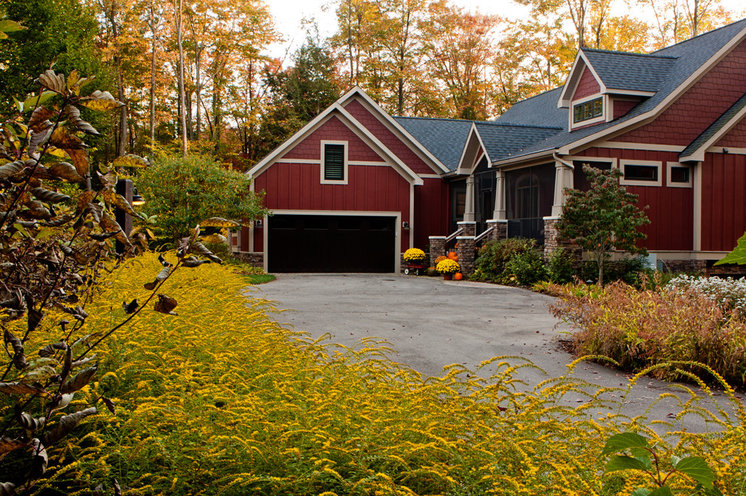Rain gutters and downspouts are designed to channel rainwater away from the home and its foundation. If they’re blocked with leaves, dirt and other debris, they can lead to:
- Falling gutters. When gutters are overloaded with debris, water or subsequent ice, they can pull away from the house and fall.
- Flooding. Water that’s prevented from flowing properly down the spout may spill over the sides, drain toward a basement or foundation and increase the risk of basement flooding.
- Cracked foundation. Cracks may form if water spills over the sides of clogged rain gutters, seeps into the foundation and freezes.
- Wood rot. Ice dams occur when water freezes inside clogged gutters. The ice can push against the roof and walls, and increase the threat of mildew or rot.
- Staining. Water that spills over the sides of clogged gutters can discolor exterior siding.
“Rain gutters are essentially the last thing people think about — until they have a problem,” says Michael Marceaux, owner of Mr. Gutter in Orange, California. When it comes to scheduling gutter maintenance, Marceaux says it depends on the house. “It would be a very good idea to clean the gutters once a year,” he says. Homes sitting beneath a lot of trees that continually drop leaves, pine needles, pine cones and other debris, for example, may need more frequent attention.
Marceaux recommends taking action early, before rains start in earnest and professionals get too busy to tackle your project quickly. If you’re doing the task yourself, check the weather forecast, says Ben Stillwell, a home improvement specialist for Lowe’s. It’s easier to clean gutters if the debris is dry.
As with any household chore, a little preparation goes a long way. Gather the tools you’ll need before you begin:
- Sturdy ladder (extension ladder for second story)
- Tarp
- Buckets with S-hooks or handled plastic bags
- Safety goggles or glasses
- Work gloves (optional latex gloves for layering under work gloves)
- Trowel or handled scoop
- Garden hose with spray nozzle (optional telescoping garden hose attachment with gutter-cleaning nozzle)
- Screwdriver to remove and reattach downspout if it runs underground
- Optional plumber’s snake for stubborn downspout clogs
Although the task of cleaning rooftop gutters is simple, the chore can quickly turn dangerous if you don’t take the necessary precautions. If you’re unsure about anything, it’s best to hire a professional. Here’s what Lowe’s recommends:
- A sturdy ladder planted firmly on level ground is step one. “Use a stepladder whenever possible on solid, level ground and don’t climb above the second-to-last step,” Stillwell says. “For two-story homes, you might have to use an extension ladder.”
- When climbing the ladder, avoid carrying tools like trowels or anything sharp inside pockets. In the worst-case scenario — a fall — you don’t want to land on the wrong end of a screwdriver. Instead, put the tools in a bucket or handled plastic bag, carry it up the ladder and hook it to the top with an S-hook or something similar.
- Wear sturdy shoes.
- Use safety goggles or glasses to protect your eyes from loose dirt and debris. Don’t get caught standing on a high ladder without being able to see.
- Avoid working near power lines that may hang near your rooftop so there’s no possibility of electric shock from coming into contact with live wires. If your roof is near power lines, consider hiring a professional.
Although there are several variations on the process, Stillwell breaks the task into the following steps:
1. Position the ladder near a downspout and spread a tarp under the section of gutter to be cleaned.
2. Hook a bucket of tools and an empty bucket to the top of the ladder. With gloved hands and a trowel, remove large debris (leaves, twigs, etc.) and dump it into the empty bucket. Work your way toward toward the opposite end, away from the downspout.
3. To clean out the remaining dirt and small debris, climb the ladder with a hose equipped with a spray nozzle. Once you’re positioned at the end of the gutter opposite the downspout, open the nozzle and flush out the gutter. The water and small debris should drain down the spout at the other end.
4. If the water doesn’t drain easily, check the downspout strainer, located at the top of the spout, for clogs and rinse off if necessary.
5. If a clogged downspout is the problem, however, you’ll work from the bottom of the spout at ground level. “If the downspout runs underground, remove it from the pipe as needed,” Stillwell says.
6. Once you’re able to access the spout, insert the hose, with the spray nozzle set to full pressure, up into the spout. After the hose is in place, turn on the water. The stream should dislodge the blockage. If it doesn’t, Stillwell suggests inserting a plumber’s snake tool into the spout (again from the bottom) to dislodge the blockage.
7. Reattach or tighten any pieces that were removed or loosened while working on the downspout.
8. Using the hose and nozzle attachment again, flush out the gutters a final time, working from the opposite end away from the downspout.
Although the basic premise of cleaning rain gutters remains the same, there are a couple of variations on the theme:
Instead of dumping the debris into a bucket, use handled plastic bags. Fill them and let them fall to the tarp for gathering up later.
And rather than climb a ladder with a hose to flush out the gutters, consider investing in a telescoping hose attachment designed specifically for gutter cleaning. This attachment has a hooked nozzle on top that directs the water into the gutter and flushes out the trough while allowing the user to remain on the ground. It’s a great tool for DIY types.
If working on ladders or climbing up several stories doesn’t sound like a task for you, it’s time to call in the pros. To find a good company, Marceaux advises looking for an experienced business that is fully licensed, bonded and insured. “When a company says that they are licensed, don’t just take their word for it,” he says. Instead, look up the company on your state’s licensing board for contractors. Make sure the provider’s license is current.
Once the work has been done, Marceaux says don’t forget to grab your umbrella on the next rainy day and inspect your gutters and spouts. “Go out and look at your downspouts,” he says. “You should be able to see the water coming out [the bottom] or hear it going through the downspout into the ground drain below. It’s going to be pretty obvious if the downspout isn’t working. … The water will be running over the top of the gutter. Gutters are like anything. You’ve got to maintain them and keep them clean.”







